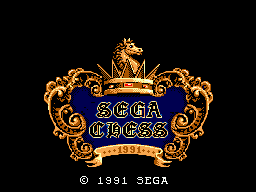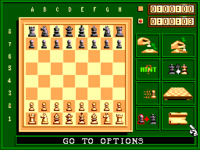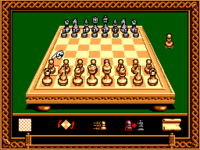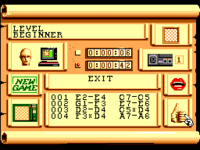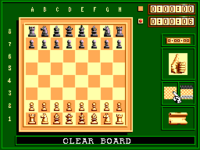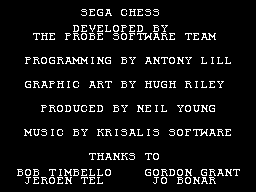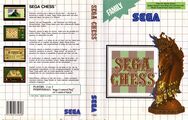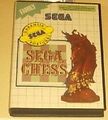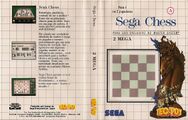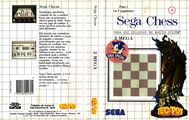Difference between revisions of "Sega Chess"
From Sega Retro
AllisonKidd (talk | contribs) (oops forgot the date) |
(expanded) |
||
| (31 intermediate revisions by 9 users not shown) | |||
| Line 1: | Line 1: | ||
| − | + | {{OtherPage|desc=the [[Sega Game Gear]] game released as "Sega Chess" in Brazil|page=The Chessmaster}} | |
{{Bob | {{Bob | ||
| bobscreen=SegaChess title.png | | bobscreen=SegaChess title.png | ||
| − | | publisher=[[Sega]] | + | | publisher=[[Sega Europe]] |
| − | | developer=[[Probe]] | + | | developer=[[Probe Software]] |
| + | | support={{company|[[Krisalis Software]]|role=audio}} | ||
| + | | distributor={{company|[[Ecofilmes]]|region=PT}}, {{company|[[Tec Toy]]|region=BR}} | ||
| system=[[Sega Master System]] | | system=[[Sega Master System]] | ||
| − | |||
| sounddriver= | | sounddriver= | ||
| peripherals= | | peripherals= | ||
| players=1-2 | | players=1-2 | ||
| − | | genre= | + | | genre=Family{{fileref|SegaChess SMS EU Box.jpg}} |
| releases={{releasesSMS | | releases={{releasesSMS | ||
| − | | sms_date_eu=1991-08 | + | | sms_date_eu=1991-08{{magref|mm|10|65}} |
| sms_code_eu=7069 | | sms_code_eu=7069 | ||
| − | | sms_rrp_uk=34.99 | + | | sms_date_uk=1991-11-14{{magref|ctw|362|27}}<!--1991-08{{magref|mm|10|65}}--> |
| + | | sms_code_uk=7069 | ||
| + | | sms_rrp_uk=34.99{{magref|mm|10|65}}<!--29.99{{magref|segapower|22|27}}--> | ||
| sms_date_au=199x | | sms_date_au=199x | ||
| − | | | + | | sms_code_au=FCHE01SEC |
| + | | sms_code_br=024340 | ||
| + | | sms_date_br=199x | ||
| + | | sms_date_bx=199x | ||
| + | | sms_date_pt=199x | ||
}} | }} | ||
}} | }} | ||
| − | + | '''''{{PAGENAME}}''''' is a video game interpretation of chess released for the [[Sega Master System]] in 1991. | |
| + | |||
| + | ==Gameplay== | ||
| + | {{ScreenThumb2|Sega Chess SMS, 2D Chessboard.png|Sega Chess SMS, 3D Chessboard.png|width=200|Chessboards}} | ||
| + | ''Sega Chess'' is a chess game that can be played by one player against the computer or by two players against each other, or players can watch a match between two computer players. The object of the game is to trap the opponent's king in a position that it cannot escape, which is called a "checkmate." It can be played from a overhead, 2D view or an isometric, pseudo-3D view. White moves first. | ||
| + | |||
| + | The game is controlled through a hand cursor, which can be moved around the board using the D-Pad. Pieces are picked up or placed down by pressing {{1}}. Placing a piece back in its original location allows the player to choose a different piece. | ||
| + | |||
| + | In the 2D view, the player can move the cursor onto an icon pane on the side that contains functions to go back a move (for either player), go forward a move (if the player has gone back a move without making another turn), show a hint for the next move, swap the white and black players, force the player to make a move (for either player), switch to the 3D view, promote a piece (when a pawn makes it to the other side of the board), or open the options screen. | ||
| + | |||
| + | In the 3D view, the player can switch between moving the cursor on the board and the icon pane by pressing {{2}}. It contains functions to switch to the 2D view, rotate the board (between white on the bottom or top), force the player to make a move (for either player), promote a piece (when a pawn makes it to the other side of the board), or open the options screen. | ||
| + | |||
| + | ===Options=== | ||
| + | {{ScreenThumb|Sega Chess SMS, Options.png|width=200|Options}} | ||
| + | {{ScreenThumb|Sega Chess SMS, Board Set-Up.png|width=200|Board Set-Up}} | ||
| + | The game presents a configuration screen upon starting with numerous options, including selecting the number of players, selecting the skill level of the computer (for one-player games), choosing between sharing a single control pad or using two separate control pads (for two-player games), toggling speech, and choosing between the 2D and 3D views. | ||
| + | |||
| + | There are nine skill levels for the computer (Beginner, Novice, Amateur, Intermediate, Professional, Chess Champion, Grand Chess Champion, Chess Master, and Grand Chess Master), which affects the amount of time that the computer is given to "think" about its next move. There are three additional levels that change the behavior of the computer: | ||
| + | *'''Adaptive:''' The amount of time that the computer is allotted is determined by averaging the amount of time that the player has spent on the last ten moves. | ||
| + | *'''Infinite Think Mode:''' The computer thinks about its next move until the player forces it to move. | ||
| + | *'''Problem Solving Mode:''' A special mode where the player can set up the board with the pieces in any legal configuration, then watch as the computer attempts to solve it in the fewest possible moves. | ||
| + | |||
| + | The options screen can be invoked at any time during gameplay. It shows the last moves for both players (which can be scrolled up or down) and a clock for each player that shows the total time spent on turns. The player can make changes or start a new game. | ||
| + | |||
| + | The Board Set-Up option lets the player rearrange the pieces on the board. The current piece can be changed by holding {{1}} and pressing {{up}} or {{down}} (which includes a blank space to remove pieces). Pieces can be placed by pressing {{2}}. | ||
| + | |||
| + | ===Pieces=== | ||
| + | {| class="prettytable" | ||
| + | ! Piece !! Description | ||
| + | |- | ||
| + | | style="white-space: nowrap;" | {{sprite | Sega Chess, Pieces.png | crop_width=16 | crop_height=16 | crop_x=0 | crop_y=0}} {{sprite | Sega Chess, Pieces.png | crop_width=16 | crop_height=16 | crop_x=0 | crop_y=16}} Pawns | ||
| + | | Pawns can move one square forward. It has the option to move two squares forward on its first move (if both squares are free). They capture pieces diagonally (the square to the left or to the right in front of the pawn). Each player starts with a rank of eight pawns in front of the rest of their pieces, making them the most numerous piece on the board. | ||
| + | |||
| + | A pawn can capture a piece using the "en passant" technique. Immediately after the opponent has moved a pawn two squares forward, if the player has a pawn next to the one that the opponent moved, the player can move diagonally backward to capture it. | ||
| + | |||
| + | A pawn is automatically promoted to a queen if it makes it all the way to the other end of the board. It can be promoted to a rook, a knight, or a bishop instead by choosing "Promote Piece" from the icon pane. | ||
| + | |- | ||
| + | | style="white-space: nowrap;" | {{sprite | Sega Chess, Pieces.png | crop_width=16 | crop_height=16 | crop_x=16 | crop_y=0}} {{sprite | Sega Chess, Pieces.png | crop_width=16 | crop_height=16 | crop_x=16 | crop_y=16}} Rooks | ||
| + | | Rooks can move any number of squares forwards, backwards, and sideways (but cannot jump over other pieces in its path). Each player has two rooks, one on each corner of the board. | ||
| + | |||
| + | If a rook and the king have not been moved yet in the game and there are no pieces in between them, they can participate in a defensive strategy called "castling." The player is permitted to move the rook next to the king (on the closer side), then move the king to the other side of the rook. Castling cannot be done if the king is in check or moves through check during the move. | ||
| + | |- | ||
| + | | style="white-space: nowrap;" | {{sprite | Sega Chess, Pieces.png | crop_width=16 | crop_height=16 | crop_x=32 | crop_y=0}} {{sprite | Sega Chess, Pieces.png | crop_width=16 | crop_height=16 | crop_x=32 | crop_y=16}} Knights | ||
| + | | Knights can move two squares forwards or backwards and then one to either side in an L shape. Knights are the only piece that can jump over other pieces, making them the only pieces besides pawns that can be moved at the start of the game. They can only capture pieces on the final square on which they land. Each player has two knights, placed between the rooks and the bishops. | ||
| + | |- | ||
| + | | style="white-space: nowrap;" | {{sprite | Sega Chess, Pieces.png | crop_width=16 | crop_height=16 | crop_x=48 | crop_y=0}} {{sprite | Sega Chess, Pieces.png | crop_width=16 | crop_height=16 | crop_x=48 | crop_y=16}} Bishops | ||
| + | | Bishops can move diagonally an unlimited number of squares (but cannot jump over other pieces in its path). Each player has two bishops, one on each side of the king and queen. | ||
| + | |- | ||
| + | | style="white-space: nowrap;" | {{sprite | Sega Chess, Pieces.png | crop_width=16 | crop_height=16 | crop_x=64 | crop_y=0}} {{sprite | Sega Chess, Pieces.png | crop_width=16 | crop_height=16 | crop_x=64 | crop_y=16}} Queen | ||
| + | | The queen can move in any direction forwards backwards, sideways, or diagonally across an unlimited number of unoccupied squares. This makes it the most powerful piece in the game, since it combines the movement of the rook and the bishop. Each player has only one queen. | ||
| + | |- | ||
| + | | style="white-space: nowrap;" | {{sprite | Sega Chess, Pieces.png | crop_width=16 | crop_height=16 | crop_x=80 | crop_y=0}} {{sprite | Sega Chess, Pieces.png | crop_width=16 | crop_height=16 | crop_x=80 | crop_y=16}} King | ||
| + | | The king can move one square in any direction, provided that it is unoccupied. Each player only has one king. If a player's king is threatened with capture, it is in "check," and the player must remove the threat of capture in the next turn (either by moving the king or capturing the piece that is threatening it). If this cannot be done, the king is in "checkmate," resulting in the defeat of that player. The player is not permitted to make a move that places their own king in check. | ||
| + | |} | ||
| + | |||
| + | ==Production credits== | ||
| + | {{creditstable| | ||
| + | *Developed by the [[Probe Software|Probe Software Team]] | ||
| + | *'''Programming by:''' Antony Lill | ||
| + | *'''Graphic art by:''' Hugh Riley | ||
| + | *'''Produced by:''' Neil Young | ||
| + | *'''Music by:''' [[Krisalis Software]] | ||
| + | *'''Thanks to:''' Bob Timbello, Gordon Grant, [[Jeroen Tel]], Jo Bonar | ||
| + | | source=In-game credits | ||
| + | | pdf=Sega Chess SMS credits.png | ||
| + | | console=SMS | ||
| + | }} | ||
| + | |||
| + | ==Magazine articles== | ||
| + | {{mainArticle|{{PAGENAME}}/Magazine articles}} | ||
==Physical scans== | ==Physical scans== | ||
| − | {{ratings | + | {{ratings|SMS}} |
| − | | | ||
| − | |||
| − | |||
| − | |||
| − | |||
| − | |||
| − | |||
| − | |||
| − | |||
| − | |||
| − | |||
| − | |||
| − | |||
| − | |||
| − | |||
| − | |||
| − | |||
| − | |||
| − | |||
| − | |||
| − | |||
| − | |||
| − | |||
| − | }} | ||
{{Scanbox | {{Scanbox | ||
| console=Master System | | console=Master System | ||
| region=EU | | region=EU | ||
| cover=SegaChess SMS EU Box.jpg | | cover=SegaChess SMS EU Box.jpg | ||
| + | | cart=SegaChess SMS EU Cart.jpg | ||
| + | }}{{Scanbox | ||
| + | | console=Master System | ||
| + | | region=PT | ||
| + | | cover=SegaChess SMS PT cover.jpg | ||
| + | }}{{Scanbox | ||
| + | | console=Master System | ||
| + | | region=BX | ||
| + | | cover=SegaChess SMS BE NL Box.jpeg | ||
| cart=SegaChess SMS EU Cart.jpg | | cart=SegaChess SMS EU Cart.jpg | ||
}}{{Scanbox | }}{{Scanbox | ||
| console=Master System | | console=Master System | ||
| region=AU | | region=AU | ||
| − | | cover= | + | | cover=SegaChess SMS AU cover.jpg |
| + | | cart=SegaChess SMS AU Cart.jpg | ||
| + | | manual= | ||
| + | }}{{Scanbox | ||
| + | | console=Master System | ||
| + | | region=AU (Hotline sticker) | ||
| + | | cover=SegaChess SMS AU hotline cover.jpg | ||
| + | | cart=SegaChess SMS AU Cart.jpg | ||
| + | | manual= | ||
| + | }}{{Scanbox | ||
| + | | console=Master System | ||
| + | | region=AU (NIAL sticker) | ||
| + | | cover=SegaChess SMS AU nial cover.jpg | ||
| cart=SegaChess SMS AU Cart.jpg | | cart=SegaChess SMS AU Cart.jpg | ||
| manual= | | manual= | ||
| Line 63: | Line 136: | ||
| cart=SegaChess SMS BR Cart.jpg | | cart=SegaChess SMS BR Cart.jpg | ||
| manual=SegaChess SMS BR Manual.pdf | | manual=SegaChess SMS BR Manual.pdf | ||
| + | }}{{Scanbox | ||
| + | | console=Master System | ||
| + | | region=BR (newer) | ||
| + | | cover=SegaChess SMS BR Box newer.jpg | ||
| + | }} | ||
| + | |||
| + | ==Technical information== | ||
| + | ===ROM dump status=== | ||
| + | {{romtable| | ||
| + | {{rom|SMS|sha1=2C386825DCE99B340084B28BDF90FB4EE7107317|md5=92334E9E52EEB8D27606E319B1F8B617|crc32=A8061AEF|size=256kB|date= |source=Cartridge (EU)|comments=|quality=|prototype=}} | ||
}} | }} | ||
==References== | ==References== | ||
<references/> | <references/> | ||
| + | |||
| + | {{SegaChessOmni}} | ||
Latest revision as of 23:34, 20 November 2024
- For the Sega Game Gear game released as "Sega Chess" in Brazil, see The Chessmaster.
| Sega Chess | |||||||||||||||||||||||||||||||||||
|---|---|---|---|---|---|---|---|---|---|---|---|---|---|---|---|---|---|---|---|---|---|---|---|---|---|---|---|---|---|---|---|---|---|---|---|
| System(s): Sega Master System | |||||||||||||||||||||||||||||||||||
| Publisher: Sega Europe | |||||||||||||||||||||||||||||||||||
| Developer: Probe Software | |||||||||||||||||||||||||||||||||||
| Supporting companies: Krisalis Software (audio) | |||||||||||||||||||||||||||||||||||
| Distributor: Ecofilmes (PT), Tec Toy (BR) | |||||||||||||||||||||||||||||||||||
| Genre: Family[1] | |||||||||||||||||||||||||||||||||||
| Number of players: 1-2 | |||||||||||||||||||||||||||||||||||
|
Sega Chess is a video game interpretation of chess released for the Sega Master System in 1991.
Contents
Gameplay
Sega Chess is a chess game that can be played by one player against the computer or by two players against each other, or players can watch a match between two computer players. The object of the game is to trap the opponent's king in a position that it cannot escape, which is called a "checkmate." It can be played from a overhead, 2D view or an isometric, pseudo-3D view. White moves first.
The game is controlled through a hand cursor, which can be moved around the board using the D-Pad. Pieces are picked up or placed down by pressing ![]() . Placing a piece back in its original location allows the player to choose a different piece.
. Placing a piece back in its original location allows the player to choose a different piece.
In the 2D view, the player can move the cursor onto an icon pane on the side that contains functions to go back a move (for either player), go forward a move (if the player has gone back a move without making another turn), show a hint for the next move, swap the white and black players, force the player to make a move (for either player), switch to the 3D view, promote a piece (when a pawn makes it to the other side of the board), or open the options screen.
In the 3D view, the player can switch between moving the cursor on the board and the icon pane by pressing ![]() . It contains functions to switch to the 2D view, rotate the board (between white on the bottom or top), force the player to make a move (for either player), promote a piece (when a pawn makes it to the other side of the board), or open the options screen.
. It contains functions to switch to the 2D view, rotate the board (between white on the bottom or top), force the player to make a move (for either player), promote a piece (when a pawn makes it to the other side of the board), or open the options screen.
Options
The game presents a configuration screen upon starting with numerous options, including selecting the number of players, selecting the skill level of the computer (for one-player games), choosing between sharing a single control pad or using two separate control pads (for two-player games), toggling speech, and choosing between the 2D and 3D views.
There are nine skill levels for the computer (Beginner, Novice, Amateur, Intermediate, Professional, Chess Champion, Grand Chess Champion, Chess Master, and Grand Chess Master), which affects the amount of time that the computer is given to "think" about its next move. There are three additional levels that change the behavior of the computer:
- Adaptive: The amount of time that the computer is allotted is determined by averaging the amount of time that the player has spent on the last ten moves.
- Infinite Think Mode: The computer thinks about its next move until the player forces it to move.
- Problem Solving Mode: A special mode where the player can set up the board with the pieces in any legal configuration, then watch as the computer attempts to solve it in the fewest possible moves.
The options screen can be invoked at any time during gameplay. It shows the last moves for both players (which can be scrolled up or down) and a clock for each player that shows the total time spent on turns. The player can make changes or start a new game.
The Board Set-Up option lets the player rearrange the pieces on the board. The current piece can be changed by holding ![]() and pressing
and pressing ![]() or
or ![]() (which includes a blank space to remove pieces). Pieces can be placed by pressing
(which includes a blank space to remove pieces). Pieces can be placed by pressing ![]() .
.
Pieces
| Piece | Description |
|---|---|
| Pawns | Pawns can move one square forward. It has the option to move two squares forward on its first move (if both squares are free). They capture pieces diagonally (the square to the left or to the right in front of the pawn). Each player starts with a rank of eight pawns in front of the rest of their pieces, making them the most numerous piece on the board.
A pawn can capture a piece using the "en passant" technique. Immediately after the opponent has moved a pawn two squares forward, if the player has a pawn next to the one that the opponent moved, the player can move diagonally backward to capture it. A pawn is automatically promoted to a queen if it makes it all the way to the other end of the board. It can be promoted to a rook, a knight, or a bishop instead by choosing "Promote Piece" from the icon pane. |
| Rooks | Rooks can move any number of squares forwards, backwards, and sideways (but cannot jump over other pieces in its path). Each player has two rooks, one on each corner of the board.
If a rook and the king have not been moved yet in the game and there are no pieces in between them, they can participate in a defensive strategy called "castling." The player is permitted to move the rook next to the king (on the closer side), then move the king to the other side of the rook. Castling cannot be done if the king is in check or moves through check during the move. |
| Knights | Knights can move two squares forwards or backwards and then one to either side in an L shape. Knights are the only piece that can jump over other pieces, making them the only pieces besides pawns that can be moved at the start of the game. They can only capture pieces on the final square on which they land. Each player has two knights, placed between the rooks and the bishops. |
| Bishops | Bishops can move diagonally an unlimited number of squares (but cannot jump over other pieces in its path). Each player has two bishops, one on each side of the king and queen. |
| Queen | The queen can move in any direction forwards backwards, sideways, or diagonally across an unlimited number of unoccupied squares. This makes it the most powerful piece in the game, since it combines the movement of the rook and the bishop. Each player has only one queen. |
| King | The king can move one square in any direction, provided that it is unoccupied. Each player only has one king. If a player's king is threatened with capture, it is in "check," and the player must remove the threat of capture in the next turn (either by moving the king or capturing the piece that is threatening it). If this cannot be done, the king is in "checkmate," resulting in the defeat of that player. The player is not permitted to make a move that places their own king in check. |
Production credits
- Developed by the Probe Software Team
- Programming by: Antony Lill
- Graphic art by: Hugh Riley
- Produced by: Neil Young
- Music by: Krisalis Software
- Thanks to: Bob Timbello, Gordon Grant, Jeroen Tel, Jo Bonar
Magazine articles
- Main article: Sega Chess/Magazine articles.
Physical scans
| Sega Retro Average | |||||||||||||||||||||||||||||||||||||||||||||||||||||||||||||||||||||||||||||||||||||||||||||||||||||||||||||
|---|---|---|---|---|---|---|---|---|---|---|---|---|---|---|---|---|---|---|---|---|---|---|---|---|---|---|---|---|---|---|---|---|---|---|---|---|---|---|---|---|---|---|---|---|---|---|---|---|---|---|---|---|---|---|---|---|---|---|---|---|---|---|---|---|---|---|---|---|---|---|---|---|---|---|---|---|---|---|---|---|---|---|---|---|---|---|---|---|---|---|---|---|---|---|---|---|---|---|---|---|---|---|---|---|---|---|---|---|---|
|
| 77 | |
|---|---|
| Based on 21 reviews | |
| Master System, BX† |
|---|
Technical information
ROM dump status
| System | Hash | Size | Build Date | Source | Comments | |||||||||
|---|---|---|---|---|---|---|---|---|---|---|---|---|---|---|
| ? |
|
256kB | Cartridge (EU) |
References
- ↑ File:SegaChess SMS EU Box.jpg
- ↑ 2.0 2.1 Mean Machines, "July 1991" (UK; 1991-06-29), page 65
- ↑ Computer Trade Weekly, "" (UK; 1991-11-11), page 27
- ↑ File:Sega Chess SMS credits.png
- ↑ Aktueller Software Markt, "Februar 1992" (DE; 1992-01-10), page 118
- ↑ Consoles +, "Février 1992" (FR; 1992-0x-xx), page 98
- ↑ Console XS, "June/July 1992" (UK; 1992-04-23), page 144
- ↑ Mean Machines: The Essential Sega Guide, "" (UK; 1993-11-18), page 153
- ↑ FX (UK) (+0:00)
- ↑ Gamers, "Februar/März 1992" (DE; 1992-xx-xx), page 49
- ↑ Games-X, "28th November-4th December 1991" (UK; 1991-11-28), page 27
- ↑ Joystick, "Janvier 1992" (FR; 199x-xx-xx), page 109
- ↑ Mega Force, "Novembre 1991" (FR; 1991-11-19), page 85
- ↑ Micromanía (segunda época), "Febrero 1992" (ES; 1992-0x-xx), page 27
- ↑ Mean Machines, "July 1991" (UK; 1991-06-29), page 66
- ↑ Mean Machines Sega, "October 1992" (UK; 1992-09-xx), page 136
- ↑ Player One, "Février 1992" (FR; 1992-xx-xx), page 83
- ↑ Play Time, "3/92" (DE; 1992-02-05), page 93
- ↑ Sega News, "Říjen 1996" (CZ; 1996-xx-xx), page 27
- ↑ Sega Power, "September 1991" (UK; 1991-08-01), page 26
- ↑ Sega Power, "October 1991" (UK; 1991-09-05), page 58
- ↑ Sega Pro, "Christmas 1991" (UK; 1991-12-12), page 70
- ↑ Sega Pro, "April 1993" (UK; 1993-03-11), page 72
- ↑ Sega Force, "January 1992" (UK; 1991-12-12), page 75
- ↑ Video Games, "1/92" (DE; 1992-02-03), page 37
| Sega Chess | |
|---|---|
|
Main page | Hidden content | Development | Magazine articles | Video coverage | Reception | |
- 1-2 player games
- EU Master System games
- All EU games
- BX Master System games
- All BX games
- PT Master System games
- All PT games
- UK Master System games
- All UK games
- AU Master System games
- All AU games
- BR Master System games
- All BR games
- Master System games
- 1991 Master System games
- All 1991 games
- Master System table games
- All table games
- All games
- Old technical information
- Sega Chess
